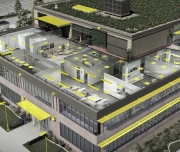System Impacts
O&M Impact
A lighting upgrade can cut energy bills, improve the look of a facility, and boost employee morale, but all those benefits can fade away if the new lighting systems are not well maintained. All lighting systems experience a decrease in light output and efficiency over time, because:
- Lamp light output decreases (lamp lumen depreciation).
- Dirt accumulates on fixtures (luminaire dirt depreciation).
- Lamps burn out.
- Control systems drift out of spec or are overridden by occupants.
Best Practices and Strategies
| Design lighting systems with components that minimize light loss over time, are easy to maintain, and use the fewest types of lamps. | Upgrade lighting economically by retrofitting components (lamps, ballasts, or reflectors) within the existing system. Replacing the lamps with appropriate lamp/ballast combination provides necessary illumination with substantial savings in energy. | Train personnel in proper maintenance techniques, including cleaning and relamping. |
| Control purchasing and inventory to ensure that only the right replacement components are available. | Plan for group relamping to reduce labor costs and maintain lighting uniformity. | Perform periodic maintenance of control systems to ensure optimized performance to avoid unwanted behavior by occupants to bypass the system. |
| Retro-commission lighting controls to ensure that they continue to work as expected and are not obscured by new furniture arrangements. | Develop an Operations and Maintenance (O&M) manual to serve as the lighting-management policy and a central operating reference for building management and maintenance staff. | Dispose of lamps properly to reduce waste; avoid sending substances like mercury and PCBs to the landfill. |

